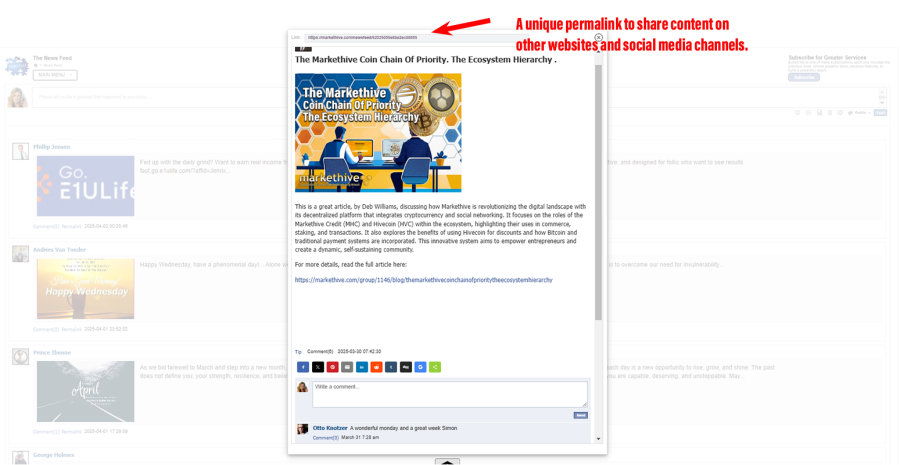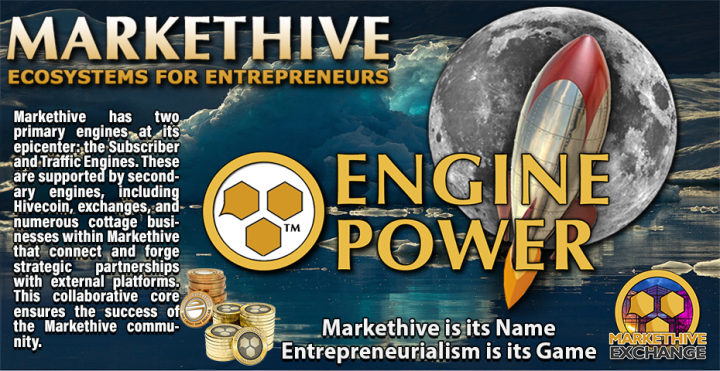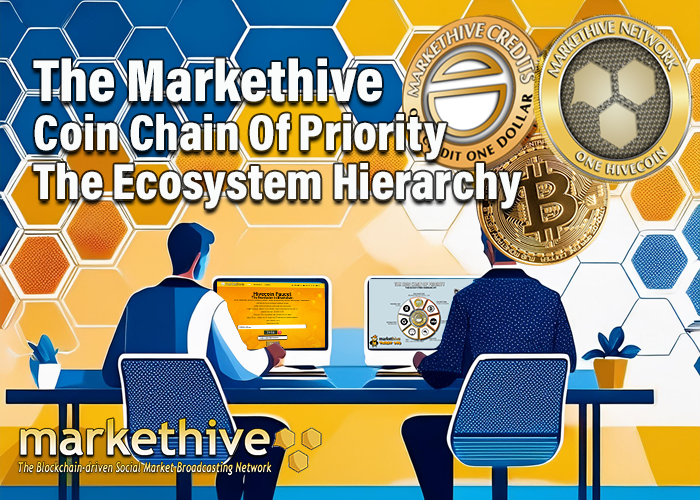
The Markethive Market Network Bill of Rights: Dedicated to Upholding Trust, Respect, and Integrity, Free from Censorship and Bias

Markethive is meticulously constructing a formidable ecosystem, designed as a sanctuary to propagate freedom worldwide, completely unencumbered by tyrannical forces and oppressive entities. This innovative platform, serving as a complete market network, is envisioned as a vibrant hub for genuine social interaction, fostering a profound sense of belonging among its members. It stands as a beacon against censorship and bias, ensuring that all voices can be heard without fear of suppression or discrimination.
At its core, Markethive is a powerful facilitator for businesses. It empowers entrepreneurs and organizations with a wide array of tools within its unique "supergroups." These supergroups serve as flexible storefronts and sophisticated e-commerce platforms, facilitating seamless transactions and customer interactions. In addition, Markethive is a comprehensive marketing and broadcasting system that allows users to share their uncensored messages and ideas globally, reaching a broad audience without fear of censorship. Through this multifaceted approach, Markethive aims to create a free and interconnected digital future for everyone.
Markethive provides a dynamic and innovative platform for artists and creatives. It offers a dedicated space for their content to achieve global reach, connecting with billions and cultivating a vast and engaged following. Beyond its powerful reach, Markethive empowers users to build a sovereign income, fostering financial independence through active participation and leveraging its diverse income-generating initiatives. This unique economic model is designed for resilience, safeguarding members' earnings from external pressures and establishing a secure foundation for their artistic pursuits.
.png)
The Shift Toward Decentralization
The inherent vulnerability of centralized internet infrastructure has become increasingly apparent, with providers exercising the power to restrict or even revoke internet access from companies and individuals who do not align with their established narratives. This poses a significant threat to free speech, innovation, and the decentralized nature that the internet was initially envisioned to embody.
In response to these growing concerns, Markethive has pioneered a groundbreaking solution designed to circumvent the limitations and control imposed by centralized entities. Their innovative approach leverages a blockchain-driven distributed database, a foundational technology that offers unparalleled resilience and autonomy. Unlike traditional databases, where data is stored on a single server, a distributed database scatters data across multiple nodes within a network, making it virtually immune to single points of failure or censorship.
This advanced technological framework is not just about bypassing centralized control; it also has the inherent ability to mint cryptocurrency. This integration is essential because it enables the development of a self-sustaining ecosystem within the Markethive community. Markethive’s cryptocurrency, Hivecoin (HVC), functions as the primary medium of exchange, encouraging participation, rewarding contributions, and supporting peer-to-peer transactions without intermediaries.
The fundamental principle behind Markethive's approach is empowering users. By giving individuals ownership of their data and providing opportunities to earn cryptocurrency through applications built on a decentralized network, a profound sense of trust is cultivated between the individual and the platform. This model diverges from the exploitative practices commonly found in centralized systems, where user data is often monetized without providing direct benefit to the data's owner.
This shift is crucial for protecting privacy, enhancing security, and ensuring that individuals retain ultimate control over their online presence and interactions. The integration of these elements within Markethive creates a truly revolutionary platform that champions user rights and fosters a more equitable and independent digital landscape, granting individuals and businesses increased freedom, security, and economic prospects.
Markethive's Commitment to Free Speech and Community Autonomy
Markethive is founded on the principle of free expression and is committed to breaking away from the widespread content policing and censorship common on many online platforms. Unlike centralized organizations that determine acceptable content, Markethive enables its community to self-regulate. This decentralized approach ensures that the responsibility for what constitutes "unacceptable content" stays with individual users, who have access to simple yet effective tools, such as blocking offending users and customizing their algorithms.
Markethive promotes a truly meritocratic culture, one that values each individual's ability to think critically and make independent judgments without imposing external narratives about "disinformation," "misinformation," or "malinformation." By doing so, Markethive challenges the very idea of "autocratic powers," which define and label certain information as illegal, questioning the legitimacy of such actions and, at the very least, suppressing genuine discourse.
Navigating the Landscape of Social Media Giants
Markethive is a comprehensive ecosystem that includes social media marketing, encompassing all facets of digital communication and broadcasting to the many social media platforms. It acknowledges the current dominance of established social media giants and the necessity of reaching audiences on these platforms. To bridge this gap without compromising its core tenets of free expression, Markethive employs an innovative strategy for its blogging and video channels.
For instance, when a video is uploaded to the Markethive video channel and broadcast on the "woke social media platforms," it's not shared in full but through "opaque summaries." This strategic obfuscation aims to bypass the artificial intelligence surveillance and algorithmic filtering systems used by these platforms. In turn, the viewer is directed back to the Markethive site to watch it in its entirety. By presenting content in a purposely ambiguous manner, Markethive significantly lowers the risk of its content being flagged or censored, especially when the subject is controversial or challenges the dominant narratives imposed by external entities.
The technical ingenuity behind Markethive’s approach extends beyond initial broadcasting. Should an "oppressive platform" decide to delete a user's video, the content remains securely preserved on Markethive’s distributed system. This robust infrastructure ensures that user-generated content, once uploaded to Markethive, is impervious to external censorship and deletion attempts.
Unyielding Content Security and User Ownership
At the heart of Markethive is its strong commitment to keeping content secure and protecting user property rights. This core principle sets Markethive apart as a haven in the often-unpredictable digital world. Every part of the Markethive network, from complex feeds to specialized channels, is built with security as its top priority, ensuring that users' intellectual property, creative work, and unique contributions stay under their control.
As the world faces growing concerns about data privacy, content manipulation, and censorship, Markethive stands out with its strong commitment to user ownership and content protection. This directly meets the increasing global demand for open, unfiltered information. By creating a platform where security is essential and intellectual property is protected, Markethive empowers individuals to access and share the truth about what’s happening around the world.
This secure and uncensored environment fosters a space where genuine dialogue can thrive, free from external interference or the risk of content theft. Ultimately, Markethive aims to build a digital ecosystem where creators are respected, their work is protected, and the free flow of authentic information is prioritized.

BILL OF RIGHTS: Your Digital Privacy and Autonomy
At Markethive, we firmly believe in empowering you, the user, with full ownership and control over your digital presence. This Bill of Rights reflects our firm commitment to your privacy, data security, and freedom of expression within our private network.
Your Information, Your Property
You are the sole owner of your personal information and content. Let us be absolutely clear: your data does not belong to Markethive. We maintain a strict ethical stance against the predatory practices that are standard elsewhere online. Therefore, you will never see targeted ads or third-party content based on your online activities or expressions within our platform. We consider such practices unethical and a violation of your privacy.
Unfiltered Connections and Unmanipulated Feeds
Markethive believes in fostering authentic connections. This means you will see every post in precise timeline order from your friends, family, and the groups you choose to join. We are dedicated to transparency and integrity; thus, we do not manipulate, filter, or alter the order of your content or what you see in your feed. Your permissions and privacy are inherent rights, and we empower you with absolute control over them. You dictate who can access your content and precisely what, if anything, others can view in member searches. Your digital footprint is yours to manage.
A Sanctuary of Privacy: Markethive's Private Network
Markethive functions as a truly private network. This distinction is essential: it means we do not track or profile you in any way. Your privacy is our top priority, and it drives our commitment to never share your personal information with anyone. We protect your data as if it were our own, recognizing the deep trust you place in us.
Respecting Your Interactions and Identity
Your "likes" and "loves" on Markethive are intended solely for personal expression and to foster connections with friends. We strictly do not monitor or mine your data for any reason. Additionally, your face is entirely your business. We clearly state that we do not use facial recognition technology on our platform. You have the right to delete your account and easily take your content with you at any time, without any obstacles or penalties. In line with our focus on data minimization and user control, we do not keep or archive logs, ensuring that your past activities stay private and temporary.

Conclusion
Markethive stands as a global beacon of empowerment, extending its reach to every nation worldwide. Through its innovative platform, it actively contributes to uplifting countless individuals, fostering an environment where fundamental freedoms flourish. It will be home to hundreds of millions of people where they can experience newfound freedom of speech and information, liberating their voices and accessing diverse perspectives without hindrance.
Beyond intellectual freedom, Markethive is a champion of financial sovereignty. It provides tools and opportunities that allow individuals to gain greater control over their economic destinies, fostering independence and self-reliance. This commitment to financial empowerment contributes significantly to the overall well-being of its users, enabling them to pursue their aspirations with greater confidence and security.
At the technological core of Markethive's operations lies its robust and independent infrastructure. Unlike many platforms that rely on third-party servers, Markethive maintains complete ownership and control of its server network, ensuring unparalleled stability, security, and autonomy.
This independence is further solidified by its foundational integration with Blockchain technology. The immutable and transparent nature of Blockchain underpins Markethive's operations, guaranteeing data integrity and user trust. Central to this secure ecosystem is Hivecoin (HVC), Markethive's proprietary cryptocurrency, which facilitates seamless transactions and reinforces the platform's commitment to a decentralized and user-centric financial model.


Tim Moseley




.png)

.png)






.png)




.png)
.png)









.png)

.png)
.png)



%20copy(1).png)
.png)



.png)




.png)
.png)



.png)
.png)